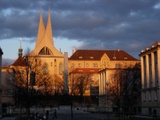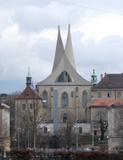Emauzy – The Monastery Na Slovanech
The Monastery Na Slovanech is bound to the famous emperor Charles IV for its foundation (1347). The ruler invited hither Slavic Benedictine monks from Dalmatia and Croatia. The area was thus destined to become the only Slavonic monastery of the entire empire. The liturgical language to be preached in was an ancient predecessor of Czech.
Why “Emauzy”?
 In the case you are asking about the name “Emauzy”, it was derived from the gospel, according to which Jesus met with his disciples near the village Emmaus. This gospel was read during the solemn consecration of the monastery and the subject was immortalized in people’s name of the place.
In the case you are asking about the name “Emauzy”, it was derived from the gospel, according to which Jesus met with his disciples near the village Emmaus. This gospel was read during the solemn consecration of the monastery and the subject was immortalized in people’s name of the place.
Another and less well known version of the story says that “Emauzy” was derived from Emmahaus (the house of Ema) nearby, which should have belonged to the castle owned by Czech queen Ema.
The importance of the monastery – both then and now
- The monastery soon became a centre of scholarship – one of the students was the famous preacher Jan Hus.
- It was and still is also a perfect place for lovers of art – on the one hand, there are the wall paintings in the Church of Our Lady, which belong to the most valuable Gothic relics. On the other hand, there are also the Gothic cloisters with mural paintings portraying scenes from the Old and the New Testament.
- The precious illuminated literary works were also created at this very place.
Each century brings something new…
- Hussites came in the beginning of the 15th century but the monks accepted their beliefs and Emauzy thus became the first and only Hussite monastery. This was very fortunate because the place avoided being plundered.
- The 16th century witnesses the transformation of the monastery into a predecessor of current entertainment centres – there was a tavern here where one could listen to musicians whilst enjoying skittles.
- The next century was a bit more serious again – the monastery became a home of the famous astronomer Johannes Kepler followed by a Baroque reconstruction by Benedictines from Spain later on. It was also them who added the two frontal bulbous towers.
- What the Spanish monks brought, their “colleagues” from 19th century Germany completely reversed. The so called Beuron style simply substituted the Baroque with Pseudo-Gothic features. The monastery also became the centre of Gregorian chant at this point in time.
- The Second World War air-raid destroyed the church but luckily the monastery was restored. The modern roof with recognizable steeples was projected by architect Cerny. This valuable representative of Prague modern architecture is made out of white concrete.
A legend about a cook from the hell
 According to some legends the monastery belongs to the haunted places of Prague – the culprit being the “Emauz devil”. The Benedictine monks were namely so heavenly-minded and virtuous that the hell itself felt disturbed. They therefore sent a cook to the monastery who prepared meals in such an excellent way that the devotional life was soon forgotten and the monks started to prefer the delights of wine and tasty dishes. Once the whole mischief came to light, though. The cook was turned into a black cock and the monks returned to their virtuous habits…
According to some legends the monastery belongs to the haunted places of Prague – the culprit being the “Emauz devil”. The Benedictine monks were namely so heavenly-minded and virtuous that the hell itself felt disturbed. They therefore sent a cook to the monastery who prepared meals in such an excellent way that the devotional life was soon forgotten and the monks started to prefer the delights of wine and tasty dishes. Once the whole mischief came to light, though. The cook was turned into a black cock and the monks returned to their virtuous habits…
How to get there:
Take the tube (yellow line B) to Karlovo Namesti (following the exit sign to Palackeho Namesti) and from the park nearby you should be able to see Emauzy only couple of metres away.
For more pictures see Emauzy photo gallery